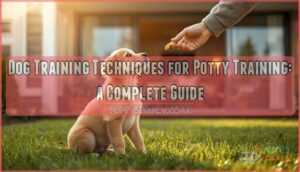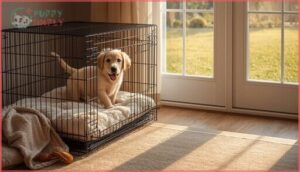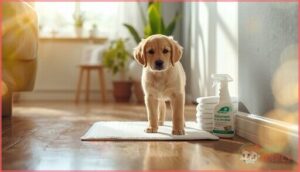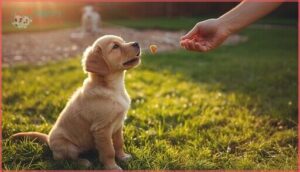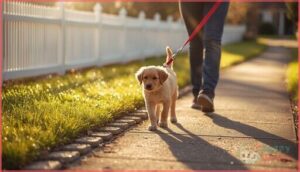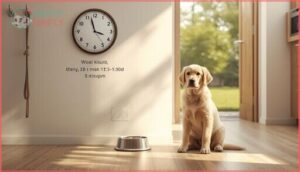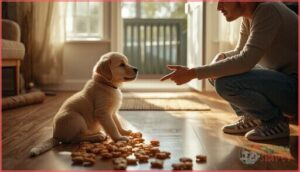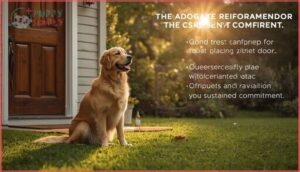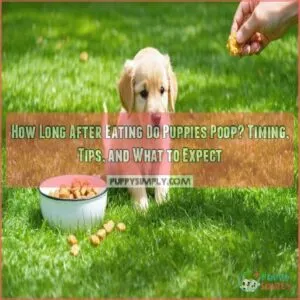This site is supported by our readers. We may earn a commission, at no cost to you, if you purchase through links.
Your new puppy just peed on the carpet for the third time today, and you’re wondering if you’ll ever reclaim your living room. Here’s the good news: consistent dog training techniques for potty training can reduce indoor accidents by 80% within just four weeks.
The difference between a frustrated owner and a confident one often comes down to understanding how dogs naturally learn and applying the right methods at the right times.
Whether you’re working with an eight-week-old puppy or an adult dog who needs a fresh start, mastering core techniques like crate training, positive reinforcement, and strategic scheduling creates the foundation for a clean home and a trusting bond with your dog.
Table Of Contents
- Key Takeaways
- Why Potty Training Matters for Dogs
- Essential Potty Training Techniques
- Creating an Effective Potty Training Schedule
- Overcoming Common Potty Training Challenges
- Maintaining Long-Term Potty Training Success
- Frequently Asked Questions (FAQs)
- How to potty train a puppy?
- Can a 3 year old child be potty trained?
- How do you teach a dog to go potty?
- How difficult is potty training a dog?
- How do you stop a dog from peeing and pooping in the house?
- How to successfully potty train a dog?
- How do you train a dog from peeing and pooping in the house?
- How do you discipline a dog for potty training?
- How to address nighttime potty accidents?
- What should I do if my puppy regresses in potty training?
- Conclusion
Key Takeaways
- Consistent potty training using crate training, positive reinforcement, and scheduled breaks can reduce indoor accidents by 80% within four weeks when you start early and maintain daily routines.
- Your puppy’s age dictates potty break frequency—eight-week-olds need breaks every 30-60 minutes, while six-month-olds can wait four to six hours between trips outside.
- Immediate rewards within 1-2 seconds of correct elimination, paired with consistent verbal cues and a designated potty spot, accelerate learning and build lasting habits.
- Enzyme-based cleaners remove scent markers that cause repeat accidents, while gradual freedom expansion and family-wide consistency prevent regression after initial training success.
Why Potty Training Matters for Dogs
Potty training isn’t just about protecting your carpet—it’s about building trust and giving your puppy the tools to succeed in your home. When you start early and stay consistent, you’re setting up a foundation that affects everything from your dog’s confidence to your daily routine.
Potty training builds trust and confidence in your puppy while protecting your home through early, consistent practice
Let’s look at why this training matters so much and what you can realistically expect along the way.
Benefits of Early Potty Training
Early start makes all the difference in house training. Your puppy can establish consistent potty routines within 2–4 weeks, cutting indoor accidents by up to 60% in that first month. This foundation aids canine development while preventing marking behavior later.
Combine crate training with positive reinforcement for better training outcomes. Remember, these housebreaking tips work best when you begin before your pup reaches 12 weeks.
Effective communication relies on using clear science terms to convey information.
Impact on Dog Behavior and Household Cleanliness
Proper potty training reduces indoor accidents by up to 80% within four weeks of consistent practice. When you keep a cleanliness routine and eliminate household odor quickly, your dog won’t return to the same spots.
Crate training and pet accident prevention also cut marking and boundary aggression—behaviors tied to confusion about elimination zones. Clean homes mean calmer dogs with better behavioral patterns and less dog anxiety overall.
Effective dog training requires understanding of research methodology to develop successful strategies.
Setting Realistic Expectations for Success
Most puppies establish reliable house training routines by four to six months when you maintain consistency. Your success metrics should include reducing accidents to just a handful weekly and building a predictable training schedule.
Expect regressions during teething or routine changes—that’s normal. Set achievable goals like “fewer than three accidents per week by week eight” and adjust your puppy training tips based on age factors and progress.
Essential Potty Training Techniques
You’ve got several proven methods to choose from when potty training your puppy. Each technique works differently depending on your lifestyle, living situation, and your dog’s needs.
Let’s walk through the most effective approaches that trainers rely on every day.
Crate Training for Housetraining
Crate training is your strongest ally in housetraining because it leverages your puppy’s natural instinct to keep their sleeping area clean. Choose a crate size that allows standing and turning but doesn’t invite accidents in the corner.
Start with short, positive sessions to build crate acclimation gradually. Take your pup out immediately after each crate period to reinforce elimination outside.
Using Puppy Pads and Paper Training
Indoor options like puppy pads and paper training offer convenient housetraining solutions when outdoor access is limited. Place your pads in a dedicated spot to build clear scent markers and mental associations. Choose high-absorbency products for better odor control, and pair each successful use with a consistent training cue like “go potty.”
Clean surrounding areas with enzymatic cleaners to prevent confusion about where elimination belongs.
Positive Reinforcement Strategies
Rewarding correct behavior immediately—within one to two seconds—accelerates puppy training and builds confidence. Use high-value treats paired with verbal cues like “go potty” each time your dog eliminates outdoors.
Clicker training sharpens timing, while praise techniques reinforce house training without over-dependence on food. Consistency methods matter: deliver rewards at the same potty spot to cement positive reinforcement and create lasting behavioral patterns.
Leash Training for Potty Breaks
A proper leash is your ally in house training—use a 4 to 6-foot lead that gives your dog freedom to sniff while you maintain control. Pair leash commands with consistent potty cues to build reliable outdoor safety habits.
- Choose the right gear: A front-clip chest strap reduces pulling during potty training sessions
- Establish a direct route: Walk the same path to your designated spot every time
- Practice weather training: Gradually expose your pup to different conditions for year-round success
Creating an Effective Potty Training Schedule
A well-planned schedule is your strongest tool in potty training success. Your puppy’s age, daily routine, and natural rhythms all play a role in when accidents happen or don’t.
Let’s break down exactly how to structure your day for the best results.
Frequency of Potty Breaks by Age
Your puppy’s bladder control develops gradually, so you’ll need to adjust potty schedules as they grow.
Puppies up to eight weeks need breaks every 30 to 60 minutes. From eight to twelve weeks, take them out every one to two hours. At three to six months, extend intervals to two to three hours. By six months, most can wait four to six hours between housetraining trips.
Best Times for Taking Puppies Out
Timing your puppy’s outings can make or break your housetraining success. Take your puppy out first thing in the morning, after every meal, following naps, and right before bed. These critical windows align with natural digestion patterns and prevent most accidents.
Smaller breeds need more frequent potty schedules than larger ones. Weather adjustments may temporarily shift your routine, but consistency remains your strongest potty training method.
Establishing a Consistent Feeding and Potty Routine
A solid housetraining foundation starts with synchronized feeding schedules and potty timing. Feed your puppy at the same times daily—this helps you predict bathroom needs like clockwork. Within 10–15 minutes after each meal, head outside to your potty spot.
Document feeding times, meal portions, and successful potty breaks to spot patterns. This routine documentation transforms guesswork into a reliable potty training method.
Choosing and Introducing a Designated Potty Spot
Now that you’ve got feeding and bathroom breaks in sync, it’s time to pick the right potty area. This spot becomes your dog’s bathroom headquarters—where every successful trip builds confidence.
Five Steps to Designate Your Potty Spot:
- Choose a consistent, accessible location in your yard or on a grass-like mat indoors.
- Select natural grass or turf surfaces that match your dog’s surface preferences.
- Position away from food bowls to avoid contamination and hesitation.
- Introduce your cue word (“go potty”) immediately as elimination begins.
- Clean accidents with enzymatic cleaners for effective odor control and housetraining success.
Take your puppy to this potty spot after meals, naps, and playtime. Pair each visit with your cue word and immediate praise when they finish. This repetition turns confusion into clarity—your dog learns exactly where potty accidents aren’t welcome and where they earn rewards.
Keep the area clean and inviting. Regularly refresh materials and use pet-safe odor neutralizers to maintain spot appeal. If your dog bypasses the designated area, reassess comfort and accessibility before adjusting your house training approach.
Overcoming Common Potty Training Challenges
Even with the best schedule and techniques, accidents will happen during potty training. Don’t let setbacks discourage you—they’re a normal part of the process.
Here’s how to handle the most common challenges you’ll face along the way.
Preventing and Managing Indoor Accidents
When accidents happen—and they will—your cleanup strategy matters just as much as prevention. Enzyme-based cleaners eliminate odors that pull your dog back to the same spot, while immediate containment sets clear boundaries. Crate management paired with scheduled breaks reduces indoor soiling during those tricky teething weeks. Stay observant and intervene quickly, and you’ll see fewer mishaps over time.
| Prevention Strategy | How It Helps |
|---|---|
| Enzyme cleaners | Remove scent markers completely |
| Immediate cleanup | Reinforces indoor boundaries |
| Scheduled crate breaks | Decreases accident frequency |
| Constant supervision | Facilitates quick intervention |
| Odor neutralization | Prevents repeat marking |
Addressing Potty Training Regression
Even well-trained dogs can backslide when routines shift or medical issues surface. Regression causes range from moving to a new home to undetected infections. Restart your crate training schedule, reintroduce your potty cue with immediate rewards, and increase supervision. Consistent reinforcement strategies rebuild trust fast. Long-term maintenance means watching for red flags and keeping every caregiver on the same page.
- Return to frequent, supervised potty breaks aligned with your dog’s age
- Use enzyme cleaners and puppy pads to manage setbacks without punishment
- Reinforce the designated outdoor spot with high-value treats every time
- Monitor for medical signs like straining or increased thirst that signal infection
Dealing With Nighttime Accidents
Your puppy’s nighttime routine sets the stage for accident prevention success. Remove water one to two hours before bed, take a final potty break, and use crate training to limit overnight freedom.
Overnight monitoring through timers helps you catch restless signals early. If sudden increases in potty accidents appear, schedule medical checks—urinary infections often reveal themselves through sleep pattern changes.
Cleaning Up Accidents and Removing Odors
When potty accidents strike, reach for an enzymatic cleaner like Nature’s Miracle or Eco88 immediately. These cleaners break down urine proteins at the molecular level, preventing your dog from re-marking the spot.
Press paper towels firmly to absorb moisture first, then apply the solution generously. For carpets, multiple applications guarantee you reach the pad beneath—proper odor removal is essential for successful housebreaking and long-term pet hygiene.
Maintaining Long-Term Potty Training Success
Once your puppy masters the basics, the real work is keeping those good habits alive. Success isn’t a finish line—it’s an ongoing commitment to consistency and awareness.
Let’s look at four key strategies that will help you maintain your dog’s potty training for the long haul.
Gradually Granting More Freedom in The Home
Your dog’s earned some freedom once they’ve consistently hit the potty spot for several weeks. Start small and supervised—this isn’t an overnight leap. Consider this roadmap:
- Grant supervised access to one new room at a time
- Watch closely for circling or sniffing during early freedom stages
- Keep sessions short initially, then gradually extend duration
- Return to crate training briefly if accidents resurface
- Celebrate each achievement with enthusiastic praise and rewards
Patience during this gradual release prevents housebreaking setbacks and reinforces your dog training success.
Monitoring for Signs of Medical Issues
Vigilance protects your dog’s health when accidents suddenly increase despite solid training. Watch for urinary tract infection signs like frequent urination or straining—these medical alerts demand veterinary care promptly.
Changes in stool consistency, lethargy, or unexplained incontinence point to canine health issues beyond training problems. Don’t ignore these pet health warnings; your vet can diagnose and treat conditions affecting dog health and hygiene.
Ensuring Family Consistency in Training
Everyone in your home must speak the same language regarding potty training—unified commands, consistent scheduling, and reward consistency build trust faster than any solo effort. Set clear supervision standards and family accountability so your dog receives identical cues from every person.
When house training techniques and positive reinforcement training align across caregivers, confusion vanishes and crate training benefits multiply through shared commitment.
Continuing Positive Reinforcement and Routine
Success isn’t a one-time event—it’s built through consistent praise delivered within 1–2 seconds of correct potty behavior. Use high-value rewards and a calm tone to create a positive association every single time.
Maintain your dog training techniques, from crate training to puppy pads, while reinforcing that predictable routine. Reward timing matters as much as the reward itself in positive reinforcement training.
Frequently Asked Questions (FAQs)
How to potty train a puppy?
Imagine this: your adorable new companion arrives, and suddenly your home becomes a minefield of accidents. Start potty training immediately with frequent breaks, positive reinforcement, and consistent scheduling to prevent chaos.
Can a 3 year old child be potty trained?
Yes, most 3-year-olds can be potty trained using child readiness cues, a potty chair, and parental consistency.
However, this article focuses on dog training methods like puppy pads and establishing a toilet routine for pets.
How do you teach a dog to go potty?
Like training wheels on a bike, teaching a dog to go potty starts with choosing one spot, using consistent commands, watching for signs, rewarding immediately, and maintaining a predictable routine.
How difficult is potty training a dog?
Most puppies need four to six months to master housetraining with consistent owner consistency.
Training setbacks from weather challenges or routine changes are normal.
Your patience and puppy training methods determine success.
How do you stop a dog from peeing and pooping in the house?
Stop accidents by using crate training, establishing consistent potty breaks every few hours, supervising closely indoors, rewarding outdoor elimination immediately, and cleaning accidents with enzyme cleaners to remove lingering odors.
How to successfully potty train a dog?
Successfully potty training your dog requires consistent supervision, frequent scheduled breaks every 2-3 hours, immediate rewards after elimination, and crate training.
Establish a designated potty spot and use positive reinforcement to accelerate housetraining methods for lasting canine behavior success.
How do you train a dog from peeing and pooping in the house?
To stop accidents, establish a designated potty spot and take your dog outside every hour. Use crate training during unsupervised times, reward outdoor elimination immediately, and clean indoor accidents with enzymatic cleaners.
How do you discipline a dog for potty training?
Don’t scold or punish accidents during potty training. Instead, use positive reinforcement and reward-based training to encourage success.
Calm redirection and gentle correction work better than harsh discipline for effective housebreaking techniques.
How to address nighttime potty accidents?
Nighttime accidents stem from bladder limitations and routine gaps. Take your puppy out right before bed and immediately upon waking. Limit water two hours prior, use crate training, and reward successful overnight potty breaks consistently.
What should I do if my puppy regresses in potty training?
When your puppy has accidents after weeks of success, return to a stricter schedule with more frequent potty breaks. Limit their freedom and increase supervision. If regression persists, rule out medical issues with your veterinarian.
Conclusion
Rome wasn’t built in a day, and neither is a perfectly housetrained dog. The dog training techniques for potty training you’ve learned here—crate training, positive reinforcement, consistent scheduling—work when you commit to the process.
Your puppy will have setbacks. You’ll clean up accidents. But stick with the routine, celebrate small wins, and trust the method.
Within weeks, you’ll walk into a clean home knowing your patience created lasting results.
- https://akc.jotform.com/252115238925860?source=16
- https://retrievist.akc.org/reviews/best-dog-crates/
- http://www.aspca.org/fight-cruelty/puppy-mills
- http://blogs.scientificamerican.com/thoughtful-animal/2012/05/31/do-dogs-feel-guilty/
- https://academichelpexpress.blog/2024/08/please-use-the-bulleted-points-and-the-rubric-below-to-guide-your-work-your-pa/

